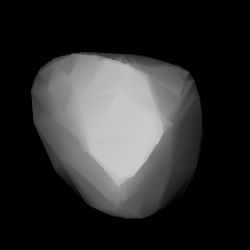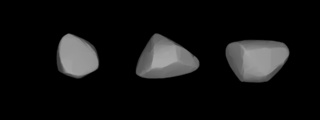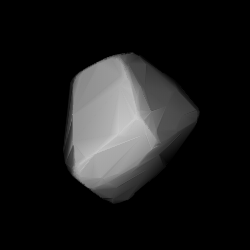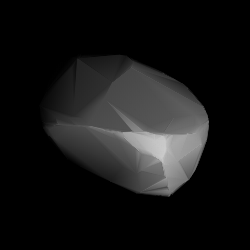6235 Burney, provisional designation 1987 VB, is a Florian or background asteroid from the inner regions of the asteroid belt, approximately 4 kilometers in diameter. It was discovered on 14 November 1987, by Japanese astronomers Seiji Ueda and Hiroshi Kaneda at the Kushiro Observatory on Hokkaido, Japan. The likely elongated L-type asteroid has a rotation period of 15.5 hours. It was named for Venetia Burney, who first proposed Pluto's name.
1151 Ithaka, provisional designation 1929 RK, is a carbonaceous asteroid from the inner regions of the asteroid belt, approximately 14 kilometers in diameter. It was discovered by Karl Reinmuth at the Heidelberg-Königstuhl State Observatory in 1929, and later named for the Greek island of Ithaca.

1165 Imprinetta, provisional designation 1930 HM, is a carbonaceous Meliboean asteroid from the outer regions of the asteroid belt, approximately 49 kilometers (30 mi) in diameter. It was discovered on 24 April 1930 by Dutch astronomer Hendrik van Gent at the Union Observatory in Johannesburg, South Africa. The asteroid was named after Imprinetta Gent, wife of the discoverer.
7317 Cabot, provisional designation 1940 ED, is a background asteroid in a resonance with Jupiter, located the inner regions of the asteroid belt, approximately 3.6 kilometers in diameter. It was discovered on 12 March 1940, by Hungarian astronomer György Kulin at the Konkoly Observatory in Budapest. The presumed S-type asteroid has a rotation period of 2.2 hours. It was named after Italian explorer John Cabot.
6398 Timhunter, provisional designation 1991 CD1, is a stony Phocaea asteroid from the inner regions of the asteroid belt, approximately 5.5 kilometers in diameter. It was discovered on 10 February 1991, by American astronomer couple Carolyn and Eugene Shoemaker, in collaboration with Canadian astronomer David H. Levy at Palomar Observatory in California, United States. It was named for American amateur astronomer Tim Hunter.
6349 Acapulco, provisional designation 1995 CN1, is a dark Adeonian asteroid from the middle region of the asteroid belt, approximately 22 kilometers in diameter.
1252 Celestia, provisional designation 1933 DG, is a stony asteroid located in the central asteroid belt. It was discovered on 19 February 1933, by astronomer Fred Whipple at the Oak Ridge Observatory operated by the Harvard-Smithsonian Center for Astrophysics in Massachusetts, United States. The S-type asteroid has a rotation period of 10.6 hours and measures approximately 20 kilometers in diameter. It was named after the discoverer's mother, Celestia MacFarland Whipple.
9298 Geake, provisional designation 1985 JM, is a Mitidika asteroid from the central regions of the asteroid belt, approximately 12 kilometers in diameter. It was discovered on 15 May 1985, by American astronomer Edward Bowell at Lowell Observatory's Anderson Mesa Station near Flagstaff, Arizona, United States. The asteroid was named for British astronomer John E. Geake.
1520 Imatra, provisional designation 1938 UY, is a carbonaceous Ursula asteroid from the outer region of the asteroid belt, approximately 54 kilometers in diameter. It was discovered on 22 October 1938, by Finnish astronomer Yrjö Väisälä at Turku Observatory in Southwest Finland, who named after the Finnish town of Imatra.
2324 Janice, provisional designation 1978 VS4, is a dark background asteroid from the outer regions of the asteroid belt, approximately 25 kilometers (16 miles) in diameter. It was discovered on 7 November 1978, by American astronomers Eleanor Helin and Schelte Bus at the Palomar Observatory in California. The asteroid was named for Janice Cline at Caltech. The presumably C-type asteroid has a rotation period of 23.2 hours.

1836 Komarov is a carbonaceous Dorian asteroid from the central region of the asteroid belt, approximately 22 kilometers in diameter. It was discovered on 26 July 1971 by Russian astronomer Nikolai Chernykh at Crimean Astrophysical Observatory in Nauchnij on the Crimean peninsula. It was named after Soviet cosmonaut Vladimir Komarov.
4045 Lowengrub, provisional designation 1953 RG, is a dark Alauda asteroid from the outer region of the asteroid belt, approximately 32 kilometers in diameter. It was discovered on 9 September 1953, by astronomers during the Indiana Asteroid Program at Goethe Link Observatory in Brooklyn, Indiana, United States. The asteroid was named after American mathematician Morton Lowengrub, dean at Indiana University and one of the fathers of the WIYN Observatory.
1936 Lugano, provisional designation 1973 WD, is a carbonaceous Adeonian asteroid from the middle region of the asteroid belt, approximately 26 kilometers in diameter.
1416 Renauxa, provisional designation 1937 EC, is an Eon asteroid from the outer regions of the asteroid belt, approximately 29 kilometers in diameter. It was discovered on 4 March 1937, by French astronomer Louis Boyer at the Algiers Observatory in Algeria, North Africa. It was named after Joseph Renaux, an astronomer at the discovering observatory.

1518 Rovaniemi, provisional designation 1938 UA, is a stony Florian asteroid from the inner regions of the asteroid belt, approximately 8 kilometers in diameter. Discovered by Yrjö Väisälä at the Turku Observatory in 1938, the asteroid was later named after the Finnish city of Rovaniemi.
4176 Sudek, provisional designation 1987 DS, is a Themistian asteroid from the outer regions of the asteroid belt, approximately 17 kilometers in diameter. It was discovered on 24 February 1987, by Czech astronomer Antonín Mrkos at the Kleť Observatory in the Czech Republic. The presumed C-type asteroid has a rotation period of 8.16 hours. It was named in memory of Czech photographer Josef Sudek.
2391 Tomita, provisional designation 1957 AA, is a Nysian asteroid from the inner regions of the asteroid belt, approximately 15 kilometers in diameter. The asteroid was discovered on 9 January 1957, by German astronomer Karl Reinmuth at Heidelberg Observatory in southern Germany. It was named after Japanese astronomer Kōichirō Tomita.
4760 Jia-xiang, provisional designation 1981 GN1, is a background asteroid from the inner regions of the asteroid belt, approximately 5 kilometers (3 miles) in diameter. It was discovered on 1 April 1981, by astronomers at Harvard University's Oak Ridge Observatory in Massachusetts, United States. The presumed stony S-type asteroid was named after Chinese astronomer Zhang Jiaxiang. It has a rotation period of 14.96 hours.

1521 Seinäjoki, provisional designation 1938 UB1, is a Brasilia asteroid from the outer region of the asteroid belt, approximately 14 kilometers in diameter. It was discovered on 22 October 1938, by Finnish astronomer Yrjö Väisälä at the southwestern Turku Observatory, Finland. The asteroid was later named after the Finnish city of Seinäjoki.
57868 Pupin, provisional designation 2001 YD, is a dark Erigonian asteroid and slow rotator from the inner regions of the asteroid belt, approximately 3.5 kilometers in diameter. It was discovered on December 17, 2001, by astronomers of Near-Earth Asteroid Tracking (NEAT) at the Palomar Observatory in California, United States. The asteroid was named after Serbian–American physicist Mihajlo Pupin.




